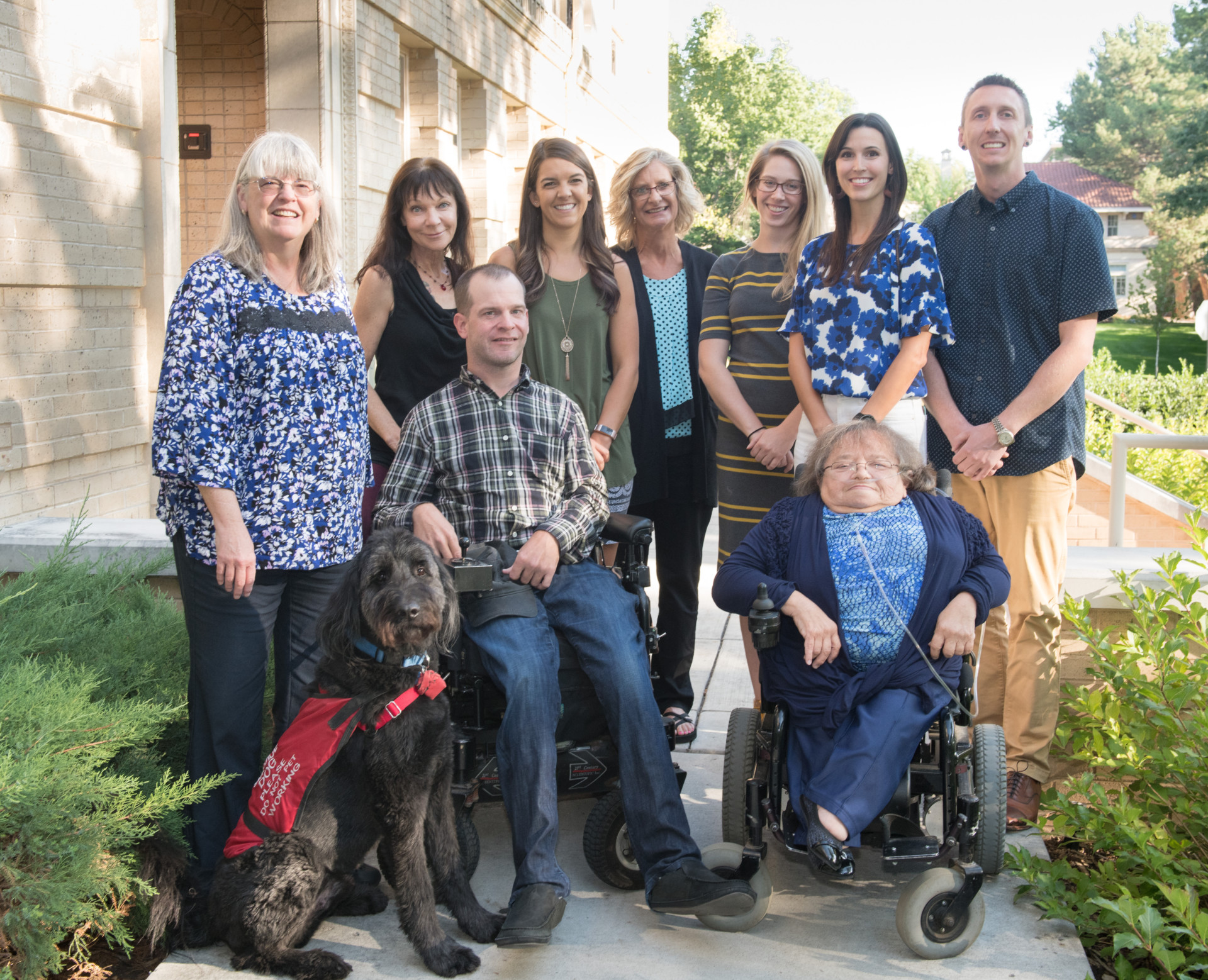
Director Rose Kreston, right front, with Student Disability Center staff Kathleen Ivy and service dog Duncan; Gina Burd; Terry Schlicting; Amanda Wimmer; Dede Kliewer; Alisha Zmuda; Brooke Simmons, and Nico Gowdy in front of the TILT Building on the Oval. Photo by William A. Cotton, CSU Photography.
Colorado State University’s Student Disability Center (formerly Resources for Disabled Students) celebrated its 40th anniversary last year. Created in 1978 in response to new federal mandates, the center has had as its mission to provide support to students as they navigate the university that often seems at odds with their human characteristics. These human characteristics affect or limit their mobility, their sight, their hearing, their learning, and/or their day-to-day living in ways that might not be discernible on the surface. These characteristics are often referred to as disabilities.
The traditional perspective of disability sees it as a stigmatized personal defect, deviance or abnormality. This “medical model” approach often results in responses that focus on the person as having a “problem” and to “help” them. Granted, some of the ‘help’ is beneficial if it minimizes the effects of the limitation. For example, a wheelchair is essential for someone who cannot walk and a sign language interpreter is essential for someone who is deaf.
These responsive efforts are meant to help the person function in, or “fit into,” the environment but may not give much regard as to how well the person is able to function or “fit in.” The limitation may be mitigated but that is only part of the picture.
The Student Disability Center views disability through a different lens. The federal mandates do not call for us to “help” a person “fit in.” Rather, they call us and the university to prohibit discrimination based on the human characteristic of having a disability/limitation. This perspective has been described as a “social model” of disability, which encompasses social justice as its core.
Social model perspective
We know that discrimination produces unjust treatment and outcomes as reflected in behavior that emanates from an environment that was not designed to include those with disabilities. A social model perspective understands that a disabled experience is created when the human characteristics affecting a person’s ability to walk, see, hear, learn and/or simply live day to day interact with an environment that did not consider they would be there.
In addition to the built environment, policies and practices that reflect a bias toward those without disabilities create an unjust environment that expects the person with the limitation to function as if they did not have the limitation.
We have students on this campus with disabilities that encompass a wide variety of limitations. The majority of the limitations of the students may not be apparent and can often be more disabling than more recognizable limitations (e.g., not able to walk, see, or hear). For example, a student with a mental health condition may experience unexpected effects of the condition and therefore may not be able to attend class or get an assignment done by a specific deadline. A student with a learning disability may not be able to process what they read on an exam or formulate their answer in a set time frame.
The accommodation we ask of the environment (i.e., faculty) is flexibility and/or extra time to give students the equitable opportunity to demonstrate their learning. The extra time or flexibility is not an advantage; it is an accommodation for the student to meet the learning objectives of the class without the disabling effect of the barrier that tests their limitation rather than their knowledge.
Higher education is a system that was once designed for a select group of individuals who “fit” a certain mold. While the mold may have been broken, we still have a system that too often creates barriers based on that original mold. We’ve made some changes to the built environment with more accessible buildings, but there is more to an environment than buildings. We still expect students to hear lectures, read books, meet attendance expectations, and adhere to specific time limits.
On behalf of students with disabilities, we ask the environment to consider and reconsider the way we do the business of educating students with all sorts of human characteristics. Acquiring a limitation of ability happens to someone every day. While living with a disability is part of the human experience, the SDC is dedicated to ensuring students are not further limited by an environment designed without consideration to their abilities as well as disabilities.
Rosemary Kreston has been the director of the Student Disability Center since 1980.